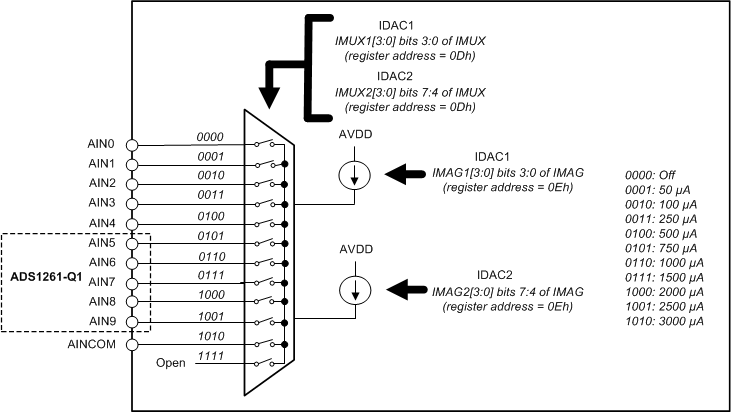JAJSGW2A January 2019 – May 2019 ADS1260-Q1 , ADS1261-Q1
PRODUCTION DATA.
- 1 特長
- 2 アプリケーション
- 3 概要
- 4 改訂履歴
- 5 概要(続き)
- 6 Device Comparison Table
- 7 Pin Configuration and Functions
- 8 Specifications
- 9 Parameter Measurement Information
-
10Detailed Description
- 10.1 Overview
- 10.2 Functional Block Diagram
- 10.3 Feature Description
- 10.4
Device Functional Modes
- 10.4.1 Conversion Control
- 10.4.2 Chop Mode
- 10.4.3 AC-Excitation Mode
- 10.4.4 ADC Clock Mode
- 10.4.5 Power-Down Mode
- 10.4.6 Reset
- 10.4.7 Calibration
- 10.5 Programming
- 10.6
Register Map
- 10.6.1 Device Identification (ID) Register (address = 00h) [reset = xxh]
- 10.6.2 Device Status (STATUS) Register (address = 01h) [reset = 01h]
- 10.6.3 Mode 0 (MODE0) Register (address = 02h) [reset = 24h]
- 10.6.4 Mode 1 (MODE1) Register (address = 03h) [reset = 01h]
- 10.6.5 Mode 2 (MODE2) Register (address = 04h) [reset = 00h]
- 10.6.6 Mode 3 (MODE3) Register (address = 05h) [reset = 00h]
- 10.6.7 Reference Configuration (REF) Register (address = 06h) [reset = 05h]
- 10.6.8 Offset Calibration (OFCALx) Registers (address = 07h, 08h, 09h) [reset = 00h, 00h, 00h]
- 10.6.9 Full-Scale Calibration (FSCALx) Registers (address = 0Ah, 0Bh, 0Ch) [reset = 00h, 00h, 40h]
- 10.6.10 IDAC Multiplexer (IMUX) Register (address = 0Dh) [reset = FFh]
- 10.6.11 IDAC Magnitude (IMAG) Register (address = 0Eh) [reset = 00h]
- 10.6.12 Reserved (RESERVED) Register (address = 0Fh) [reset = 00h]
- 10.6.13 PGA Configuration (PGA) Register (address = 10h) [reset = 00h]
- 10.6.14 Input Multiplexer (INPMUX) Register (address = 11h) [reset = FFh]
- 10.6.15 Input Bias (INPBIAS) Register (address = 12h) [reset = 00h]
- 11Application and Implementation
- 12Power Supply Recommendations
- 13Layout
- 14デバイスおよびドキュメントのサポート
- 15メカニカル、パッケージ、および注文情報
パッケージ・オプション
メカニカル・データ(パッケージ|ピン)
- RHM|32
サーマルパッド・メカニカル・データ
- RHM|32
発注情報
10.3.6 Sensor-Excitation Current Sources (IDAC1 and IDAC2)
The ADC incorporates two current sources that are used to provide excitation current to a resistive temperature device (RTD), thermistor, diode and other sensor type that require constant current biasing. The currents are programmable over the 50 μA to 3000 μA range and are internally multiplexed to all analog input pins. The current source multiplexer is shown in Figure 19. The IMUX1 and IMUX2 register bits connect the corresponding current source to the analog inputs. The IMAG1 and IMAG2 register bits program the corresponding current magnitude.
Enable the internal reference for current source operation. The current source value can be doubled or an intermediate value produced by connecting the current sources to the same analog input. Take care not to exceed the current source compliance voltage range. That is, when the current source is loaded by resistance, the voltage at the pin increases and must not exceed specification; otherwise the specified current source accuracy is not met.
 Figure 19. Current Source Connection
Figure 19. Current Source Connection